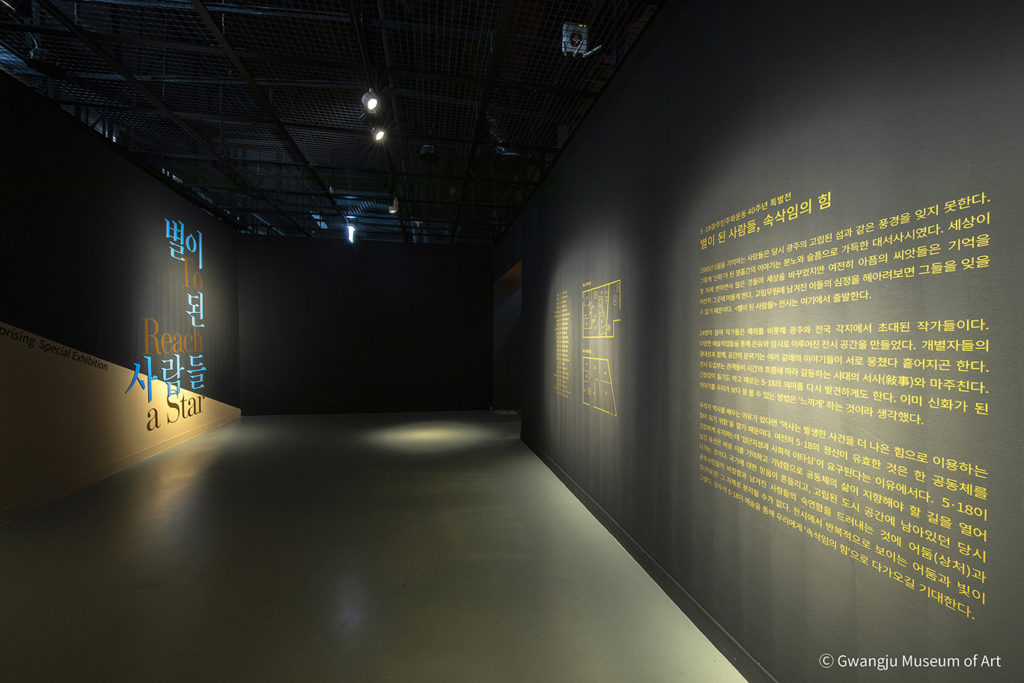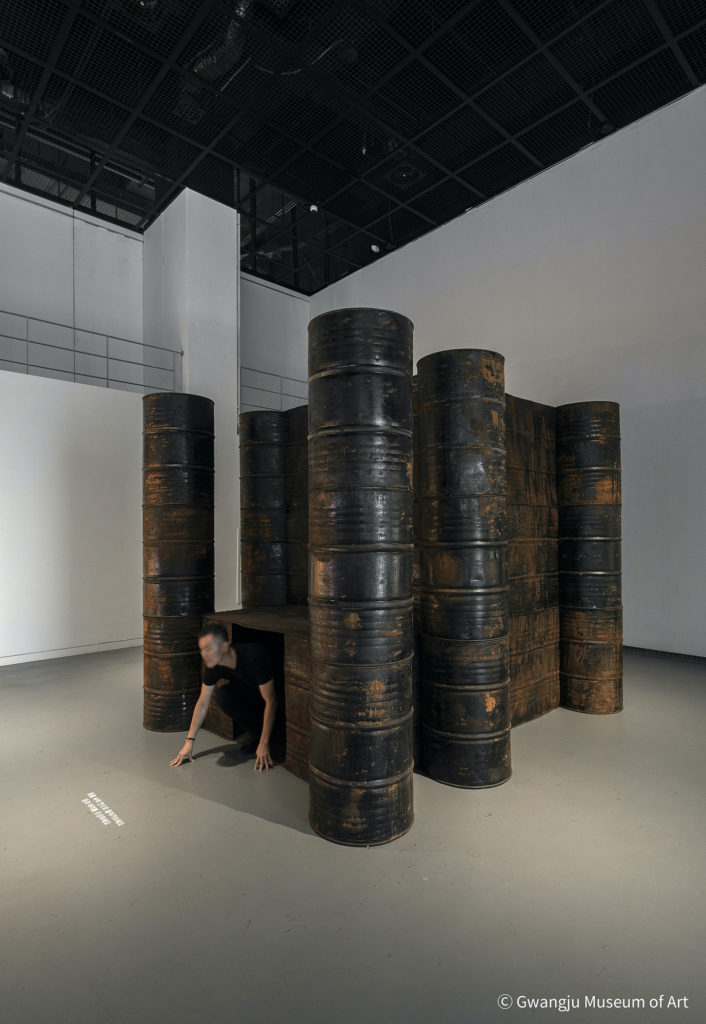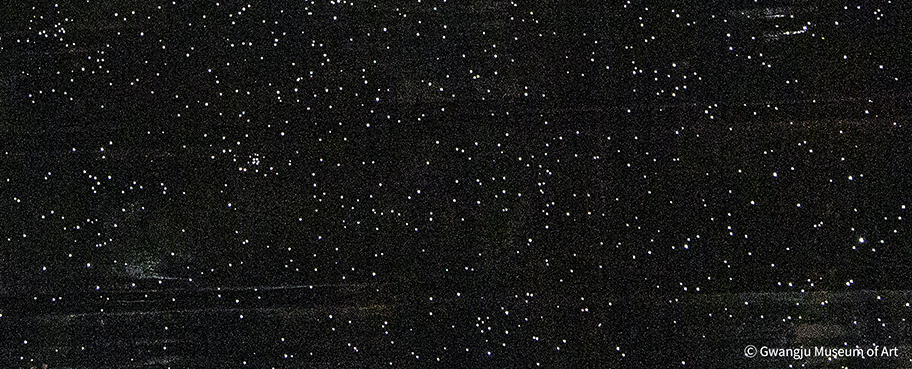“To Reach a Star”
May 18 Anniversary Exhibition
Written by Lee Aekyeong.
Cultural Memory
“Cultural memory” is a collection of memories chosen to be remembered and reproduced in the present; this continuity forms the identity of a group bonded by the contemporary narrative frame of the past. “Cultural memory” is thus a form of cultural heritage wherein the historical value of having a collective memory emerges in contemporary times. This distinctive feature gathers together members of the public who share common interpretations of the past and understand its value for the present and the future, something that inspires commemoration. Thus, although the original source of a cultural memory comes from the memories of those who directly experienced an event, cultural memory forms a group identity by mediating recollections and connecting the past and the present through cultural and societal interpretations.

When it comes to the cultural memory of a difficult history that includes social injustice, the group identity becomes more expressive and reinforces a sense of integrity and endurance through memorial activities as ethical obligations that provide special ties between members of the group. Therefore, the cultural memory of a disruptive past event becomes a core piece of the identity formation that individual and institutional members of a community have chosen to sustain in the form of a contemporary narrative.
“To Reach a Star”: 40th Anniversary Exhibition
In Gwangju, the Gwangju Democratic Uprising in 1980, commonly referred to as “May 18,” has become a core foundation of its group identity as a major cultural memory. Since it opened in 1992, the Gwangju Museum of Art has organized special exhibitions themed to present the spirit of democracy, human rights, and peace derived from this painful history. On the 15th of August, 2020, the museum opened an exhibition for the 40th anniversary of May 18, titled “To Reach a Star,” to deliver future-oriented messages with hope arising from the collective intelligence and societal altruism that Gwangju citizens showed in 1980.

What is special about this exhibition is that it tries to move beyond the sorrow and anger by adopting a form of contemporary art rather than a realistic, documentary-like presentation. The metaphoric messages of the exhibition soften the tension and conflicts regarding the disruptive topic while giving the events a powerful voice. Eventually, the metaphoric and artistic presentation of the difficult history allows the museum to attract a broader range of audiences, including younger generations and those from different cities and countries who have not experienced May 18 and feel uncomfortable discussing it.
As Jun Seung-bo, director of the Gwangju Museum of Art, explained, this special exhibition for May 18 revives this valuable moment in history by restructuring the past and present through art as well as by constructing the unity and bond of community for a better future. By doing so, the mystic story of May 18 can be heard again through the audience’s feelings and emotions from the metaphoric artwork. As Aristotle said, “Metaphor has greater clarity, pleasure, and originality.” Similarly, Jun hopes the audience will participate in the current discourse about May 18 at the exhibition and learn about the present state of the topic. He believes that the spirit of May 18 is still valid since collective intelligence and societal altruism are required to maintain our community health. “To Reach a Star” is the exhibition in which universal values of humankind are embedded.
The representative artwork for this exhibition is “Dark Room – Gwangju,” installed by Sheela Gowda. The repurposed drums used for this certain artwork were gathered from a rural area in India where most people make their shelters from waste. Their shelters are tiny inside, but when they look up, they can see bright stars in the night sky through holes in the ceiling. In this exhibition, the starlight in the darkness represents the sacrifice and altruism that the victims of May 18 showed us in 1980 as well as their hope for a bright future. This installation reminds us of the famous quote of Oscar Wilde, “We are all in the gutter, but some of us are looking at the stars.”

The artwork I like the most is “Table of May” created by a group of young curators known as the Jangdong Collective. The Jangdong Collective adopted a form of meokbang, an eating show where a host interacts with viewers while eating foods, to remember May 18. They invited senior women who directly experienced May 18 in 1980 and listened to their stories while cooking and eating together. This familiar form of presentation allows an audience without first-hand experiences or memories of the painful history to feel more comfortable and open about discussing May 18.
Overall, this exhibition shows the high capability of art for reconciliation and de-traumatization by engaging with diverse generations and intensifying the public discourse about May 18. Beyond generations and regions, the spirit of May 18 has been manifested as a universal value of humankind that has become the identity of Gwangju. If you want to take a moment for yourself to think about the message that the history of May 18 conveys to us, visit the exhibition, “To Reach a Star” at the Gwangju Museum of Art. You will encounter the sublime beauty that emerged from the sorrow and pain of May 18.
Further Information About the Exhibition and Museum
The exhibition closes on January 31, 2021. The gallery experience is controlled with one-way signage, bookable time slots online, and limited visitor numbers due to the present social-distancing regulations. For further information, please visit the website of the Gwangju Museum of Art (http://artmuse.gwangju.go.kr).

The Author
Lee Aekyeong is an international residency manager and curatorial assistant at the Gwangju Museum of Art. She is currently taking the master’s degree program in psychology and neuroscience at King’s College, London, for interdisciplinary research in the museum sphere. With a great interest in art, she interviews local artists and art enthusiasts, in addition to reviewing exhibitions.
Instagram: @evevievy







